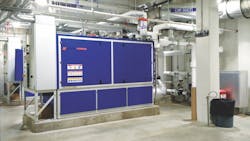Cost: $10 million
Location: Kenosha, Wis.
Year: 2017-12-13
Size: 22 mgd
Owner: Kenosha Water Utility
Designers: Donohue & Associates
Contractor: J.F. Ahern, Pieper Electric, C.D. Smith
Walking distance from the coast of Lake Michigan tucked into a neighborhood, the Kenosha Water Utility serves a community of a little less than 100,000 people. The utility sought to improve its energy use and better recover resources for its processes. The utility also looked to rehabilitate its failing solids handling building and repurpose it for combined heat and power.
“The project transformed and improved our treatment process in many ways,” said Melissa Arnot, P.E., director of operations for Kenosha Water Utility. “The installation of fine screens in the headworks has reduced our maintenance costs by removing rags before they enter the plant and it has improved our end product. … We are creating more biogas, and we are using that gas to generate power and thermal energy.”
The cornerstone of the upgrade is a thermo-chemical hydrolysis unit—Pondus—that increases the biogas production from the plant’s anaerobic digesters by breaking apart the waste-activated sludge cells prior to digestion. This process improves the sludge dewatering and preheats the sludge prior to digestion. Digestion was further improved with new mixers, and because the primary and waste-activated sludges were thickened, the plant could reduce the total number of digesters it needed.
These upgrades all led to one ultimate goal: a self-sustained facility.
“The Pondus system and the dryer are heated by thermal energy produced by the combined heat and power units,” Arnot said. “The electricity produced is utilized first by all of the new equipment and the excess is sent to the rest of the plant to be utilized. By operating Pondus, we are creating more gas, which allows the CHPs to have a higher output of electrical and thermal energy.”
Coordination between many entities was required to upgrade the plant without disrupting the current processes that provide services to Kenosha residents. The Pondus system, Arnot said, was the first use of an electro-hydrolysis unit in the U.S., as were the sludge dryer and the odor control unit. Eliminating bad odors was a crucial aspect of the project because of the plant’s proximity to the nearby residential area, and after the plant completed the project, the public was invited to see the plant firsthand.
Arnot said this public outreach was an important aspect of the project as the general public does not fully understand what water and wastewater facilities do day-to-day.
“The project is important in utilizing the treatment process byproducts for beneficial reuse,” Arnot said. “Many people now call wastewater treatment plants, wastewater resource recovery facilities. Instead of flaring methane gas, we are using it to produce electricity and thermal energy. Instead of disposing of our waste at a landfill, we are using the valuable nutrients.”
Kenosha Water Utility achieved Class A designation for its biosolids and has begun outreach to provide them to local farmers. Arnot said she also has experimented with the biosolids for landscaping at the facility to see their effects first hand. In fact, Arnot said Kenosha Water Utility is still learning about much of the equipment.
“We are continually learning and trying various ways to continue to optimize the process,” Arnot said. “There are a number of variables that are out of our control, such as the weather and the constituents of our incoming waste stream. These factors greatly affect our plant operations.”
She said Kenosha experienced a large rain event near the beginning of August in which the plant received 4.5 in. of rain in a single day and another 3.5 in. the following two days. That event helped her and her team identify a waste stream with a high concentration of grease that had been affecting its processes.
While the project had its hiccups, Arnot said it has become a source of pride for the utility.
“This was a difficult project, which involved a tight construction schedule and a lot of different types of equipment,” Arnot said. “It is not easy to start up, learn, and operate this many new pieces of equipment in a short period of time. I’m proud that we were willing to try new treatment processes, that our staff has learned the equipment and that the project is operating as it was designed.”
Project Year: 2017-12-13Contractor: J.F. Ahern, Pieper Electric, C.D. SmithDesigners: Donohue & AssociatesOwner: Kenosha Water UtilityLocation: Kenosha, Wis.Cost: $10 millionSize: 22 mgd

